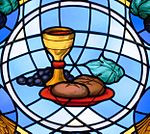This article includes a
list of references,
related reading, or
external links, but its sources remain unclear because it lacks
inline citations. (July 2020) |
| Part of a series on the |
|
Eucharist |
|---|
 |
The antimins (from the Greek Ἀντιμήνσιον, Antimension: "instead of the table"), is one of the most important furnishings of the altar in many Eastern Christian liturgical traditions. It is a rectangular piece of cloth of either linen or silk, typically decorated with representations of the Descent of Christ from the Cross, the Four Evangelists, and inscriptions related to the Passion. A small relic of a martyr is sewn into it. In the Latin Church of the Catholic Church, the altar stone serves a similar function.
Syriac practice
A wooden tablet, the ţablîtho, is the liturgical equivalent of the antimins in the churches of Syriac tradition.
See also
Further reading
- Antimensium article in the Catholic Encyclopedia
- Coptic Antimensium article in the Claremont Coptic Encyclopedia
This article includes a
list of references,
related reading, or
external links, but its sources remain unclear because it lacks
inline citations. (July 2020) |
| Part of a series on the |
|
Eucharist |
|---|
 |
The antimins (from the Greek Ἀντιμήνσιον, Antimension: "instead of the table"), is one of the most important furnishings of the altar in many Eastern Christian liturgical traditions. It is a rectangular piece of cloth of either linen or silk, typically decorated with representations of the Descent of Christ from the Cross, the Four Evangelists, and inscriptions related to the Passion. A small relic of a martyr is sewn into it. In the Latin Church of the Catholic Church, the altar stone serves a similar function.
Syriac practice
A wooden tablet, the ţablîtho, is the liturgical equivalent of the antimins in the churches of Syriac tradition.
See also
Further reading
- Antimensium article in the Catholic Encyclopedia
- Coptic Antimensium article in the Claremont Coptic Encyclopedia